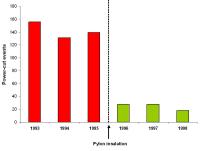
MME (BirdLife in Hungary) in collaboration with electricity providers and the Ministry of Environment and Water in Hungary and aided by a new “Accessible Sky” agreement is working to successfully lower bird powerline mortality and aims to make Hungary’s powerlines safer by 2020.

Recent national surveys coordinated by the Hungarian Ornithological and Nature Conservation Society (MME: BirdLife in Hungary) have revealed that over 30,000 birds are killed by powerlines, electricity poles and pylons in Hungary every year. Raptors and corvids are among the most affected, with electrocution a significant source of mortality for globally threatened Saker Falcon Falco cherrug and Eastern Imperial Eagle Aquila heliaca (classified as Endangered and Vulnerable on the 2008 IUCN Red List respectively), and Red-footed Falcon Falco vespertinus (classified as Near Threatened and declining in Europe). Electricity pylons annually account for 95% of human-induced White Stork Ciconia ciconia mortality in Hungary, and it is estimated that every year one in seven pylons kills a bird and one in eighteen kills a raptor (BirdLife International 2004, Demeter et al. 2004, BirdLife International 2008, K. Nagy and M. Horváth in litt. 2008).

For several years MME has been working in collaboration with electricity providers and the Ministry of Environment and Water in Hungary (MEW) to make these high mortality rates a thing of the past. MME has developed an insulating plastic cover for the metal crossarms of electricity poles to reduce the risk of electrocution for birds, and thanks to the voluntary work of electricity providers over 50,000 insulators have now been fitted. The number of electrocution events on stretches of powerline retrofitted in such a way has declined significantly as a result (Vincze 2000, Bagyura et al. 2004; see figure). MME has also designed and installed around 6,000 nesting platforms for White Stork Ciconia ciconia (80% of which nest on electricity poles in Hungary), and in collaboration with electrical engineers a new design of electricity pole has been developed which is proven to be effective in reducing the number of bird casualties (Haas et al. 2003, MEW 2005). Despite these efforts however, c.215,000 pylons are still considered to be highly-dangerous to birds within Hungary and electricity providers are not legally obliged to re-fit existing powerlines or to build newer safer models (Bagyura et al. 2004, Demeter et al. 2008).
Fortunately this is now about to change as MME, MEW and electricity providers have signed a voluntary agreement (the “Accessible Sky” agreement) which will form the basis of a long-term solution to bird electrocution in Hungary. In signing the agreement the parties have promised to manage and transform all dangerous powerlines in Hungary in order to make them more ‘bird-friendly’ by 2020. MME and MEW are now preparing a detailed map of the most dangerous areas and indicating priority stretches for retrofitting based on location, the distribution of priority bird species and observed mortality rates of those species.
Related Case Studies in other sections
Related Species
Links
References
Compiled: 2008
Recommended Citation:
BirdLife International (2008)
Safer powerlines for Hungary's birds.
Downloaded from https://datazone.birdlife.org/sowb/casestudy/safer-powerlines-for-hungary's-birds on 22/12/2024